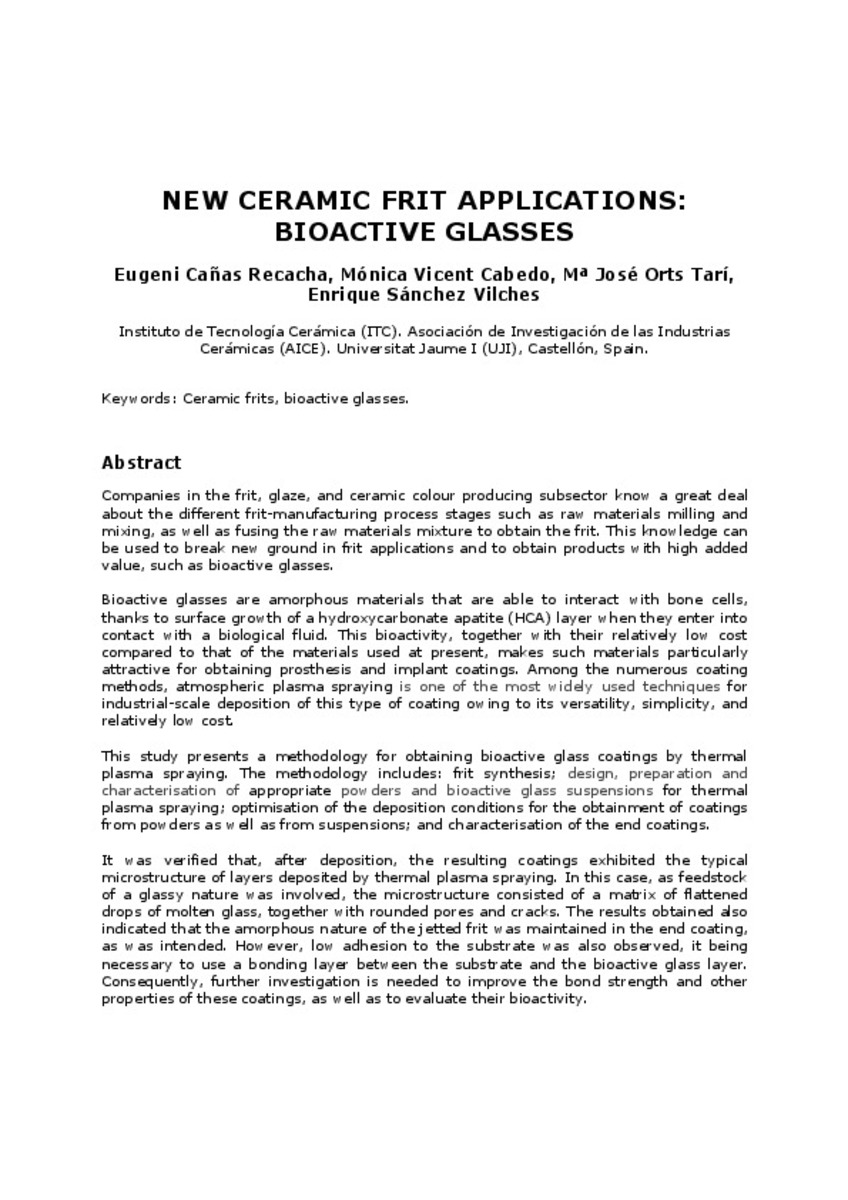Mostrar el registro sencillo del ítem
Nuevas aplicaciones de las fritas cerámicas: vidrios bioactivos
| dc.contributor.author | Cañas Recacha, Eugeni | |
| dc.contributor.author | Vicent Cabedo, Mónica | |
| dc.contributor.author | Orts Tarí, María José | |
| dc.contributor.author | Sánchez-Vilches, Enrique | |
| dc.date.accessioned | 2016-04-07T14:01:02Z | |
| dc.date.available | 2016-04-07T14:01:02Z | |
| dc.date.issued | 2016 | |
| dc.identifier.citation | CAÑAS RECACHA, Eugeni; VICENT CABEDO, Mónica; ORTS TARÍ, Mª José, SÁNCHEZ VILCHES, Enrique. Nuevas aplicaciones de las fritas cerámicas: vidrios bioactivos . En: QUALICER. Congreso mundial de la calidad del azulejo y del pavimento cerámico (14º : 2016) | ca_CA |
| dc.identifier.uri | http://hdl.handle.net/10234/156665 | |
| dc.description.abstract | Companies in the frit, glaze, and ceramic colour producing subsector know a great deal about the different frit-manufacturing process stages such as raw materials milling and mixing, as well as fusing the raw materials mixture to obtain the frit. This knowledge can be used to break new ground in frit applications and to obtain products with high added value, such as bioactive glasses. Bioactive glasses are amorphous materials that are able to interact with bone cells, thanks to surface growth of a hydroxycarbonate apatite (HCA) layer when they enter into contact with a biological fluid. This bioactivity, together with their relatively low cost compared to that of the materials used at present, makes such materials particularly attractive for obtaining prosthesis and implant coatings. Among the numerous coating methods, atmospheric plasma spraying is one of the most widely used techniques for industrial-scale deposition of this type of coating owing to its versatility, simplicity, and relatively low cost. This study presents a methodology for obtaining bioactive glass coatings by thermal plasma spraying. The methodology includes: frit synthesis; design, preparation and characterisation of appropriate powders and bioactive glass suspensions for thermal plasma spraying; optimisation of the deposition conditions for the obtainment of coatings from powders as well as from suspensions; and characterisation of the end coatings. It was verified that, after deposition, the resulting coatings exhibited the typical microstructure of layers deposited by thermal plasma spraying. In this case, as feedstock of a glassy nature was involved, the microstructure consisted of a matrix of flattened drops of molten glass, together with rounded pores and cracks. The results obtained also indicated that the amorphous nature of the jetted frit was maintained in the end coating, as was intended. However, low adhesion to the substrate was also observed, it being necessary to use a bonding layer between the substrate and the bioactive glass layer. Consequently, further investigation is needed to improve the bond strength and other properties of these coatings, as well as to evaluate their bioactivity. | ca_CA |
| dc.description.sponsorShip | The authors of this study thank Universitat Jaume I of Castellón for the support provided in funding the project RECUBIO (P1–1B2013–69) and thank the company FRITTA, S.L. for the fusion of the material in a pilot furnace. | |
| dc.format.extent | 5 p. | ca_CA |
| dc.format.mimetype | application/pdf | ca_CA |
| dc.language.iso | eng | ca_CA |
| dc.rights.uri | http://rightsstatements.org/vocab/CNE/1.0/ | * |
| dc.subject | Ceramic frits | ca_CA |
| dc.subject | Bioactive glasses | ca_CA |
| dc.title | Nuevas aplicaciones de las fritas cerámicas: vidrios bioactivos | ca_CA |
| dc.type | info:eu-repo/semantics/conferenceObject | ca_CA |
| dc.rights.accessRights | info:eu-repo/semantics/openAccess | ca_CA |







